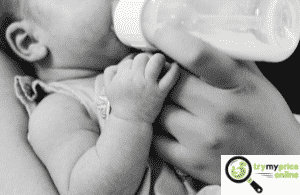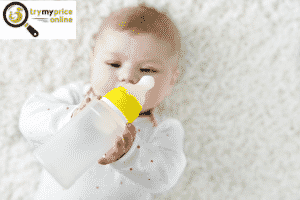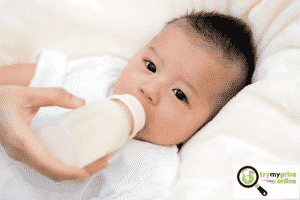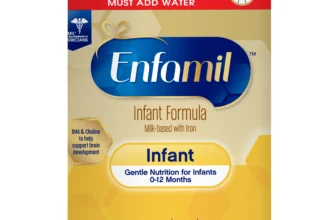
Do you know is Switching Formula affectable or not? Babies’ digestive systems are still growing, and they may experience feeding difficulties. A parent may pick from hundreds of different formulas, all of which they claim to be fantastic for their children. Why do we have different formulas? Every baby is unique. This is why there are so many different types to address various necessities, including reflux, constipation, colic, and more. With so many options, it’s tempting to question if the formula you’re using is suitable for your child. Consider seeing your baby’s doctor if you have worries that there may be a better formula alternative available. While it may appear to be a slight change in formula, it can have a substantial influence on your baby’s developing digestive system. If you’re considering switching your baby’s formula, it is best to seek the answer to the question; how long should I wait between switching formula? This article will detail how long you should wait between switching formula and every other concern regarding switching baby formula.
Switching Formula
Before you contemplate switching formula, you need first to figure out what’s driving your urge to do so. Most parents consider switching formula because of two factors: their child’s temperament or gastrointestinal issues. Let’s take a look at what we should think in these two areas:
Temperament
Because their infant is cranky, many parents contemplate switching formula. It’s common to think that their formula causes a baby’s temperament and that switching to a different formula would make the infant happier. What is the issue? Babies cry for several reasons, and determining the cause is practically difficult. Some of the causes of a baby’s unhappiness include:
- Overstimulation
- Hunger
- Overtiredness
- Temperature sensitivity
- Discomfort
- Wet or dirty diaper
- Overfeeding
Furthermore, each infant has a personality. For some families, the dream of a smiling, happy-go-lucky infant is not a reality.
Some babies, for whatever reason, have a more challenging time adjusting to life outside the womb than others, and these babies may take longer to find their footing. A fussy baby, or even one diagnosed with colic, does not always mean an issue with their formula.

Switching formula side effects
Gastrointestinal Symptoms
What about Switching Formula?
Many parents are upset if they feel their child is in pain. Gas, infrequent bowel motions, straining, spit-up, and hiccups are all symptoms you should take seriously. The difficulty is determining what is expected in infant gastrointestinal symptoms and what may suggest a problem.
It’s vital to remember that newborns’ digestive systems are still developing.
Never before has the delicate, squishy tummy been required to digest food by mouth!
Due to a perfect storm of circumstances, many newborns have digestive problems that do not include their dietary source.
Tummy problems in infants can be caused by a variety of things, including:
- A pancreas that is still growing and generates minimal quantities of digesting enzymes.
- An esophageal valve is still growing and not entirely closed to prevent reflux.
- A mucosal barrier in the stomach and intestines is still growing to protect against germs and bacteria.
- A gut microbiota that is still evolving to promote good digestion.
As a result of these circumstances, all newborns occasionally suffer gastrointestinal symptoms such as gas and spit-up. Some people may see mucus in their stools on occasion. Whether you’re Switching Formula for digestive concerns, check with your physician to see if your baby’s problems are merely a natural reaction to an immature and maturing digestive system.
How Long Does it Take a Baby To Adapt To a Switch in Formula?
How about Switching Formula?
If you decide to bottle feed your baby, you’ll need to think about the sort of formula you’ll use. Not all formulas are created equal. One could make your kid vomit up, another might give him gas, and a third might be ideal.
The problem is that changing your baby’s formula regularly might harm them. Babies’ digestive systems are undeveloped and exceedingly sensitive. As a result, it may hurt their stomach.
You’ll also want to give your infant some time to acclimate to the new formula. If your child experienced gas before and still has gas on their new formula, it’s possible that they haven’t adjusted yet.

Switching formula baby won t eat
How Long Do Babies Need to Adjust to a New Formula?
In a week, some newborns will acclimatize to a new formula. Other infants may take up to six weeks longer.
Rather than providing your infant with a new formula, you might want to pay attention to any signs and pain. Documenting it is one of the simplest methods to do so.
Keep track of how often your infant has a bowel movement, for example, if they are constipated.
Any new symptoms, such as gas or indicators of pain, should be noted. You may examine earlier symptoms to evaluate if your kid is improving or not as you keep note of those symptoms.
If they aren’t, it’s possible that they haven’t adjusted yet or that a different formula is required. Give your physician a call if your child’s condition hasn’t improved in three weeks.
How Long Do I See Side Effects After Changing My Baby’s Formula?
A week is usually enough time for an infant to completely adjust to the new formula. If your baby’s symptoms were the reason for the change in formula, you might keep track of them.
Some newborns change rapidly, and their tummies may also need to adjust.
It’s a good idea to keep track of the amount of formula consumed, the consistency of the excrement, the sleep pattern, spitting up, skin changes, and the presence of blood in the stool.
Give your pediatrician a call if you notice anything unusual.
How Long Should I Use a New Formula Before Making the Switching Formula?
Allow your baby enough time to adapt to a new formula, usually three to five days. Some babies will acclimatize almost immediately.
Others may have minor changes in stool pattern, flatulence, or spitting while adjusting to the new formula.
Consult your infant’s pediatrician if you have any questions or concerns.
Switching Formula
If you notice that the formula you’re giving your baby isn’t working for them anymore, you may need Switching Formula.
If you discover that your baby is gassy, constipated, or vomiting up more than usual, you may be forced to change formulas.
However, you must exercise extreme caution because each baby’s digestive system is unique, and the new formula may aggravate the condition if your child cannot digest it properly.
How Long Does It Take Formula Change to Take Effect?
Pediatricians often advise letting a baby two weeks to see how the new baby formula works in their system. Depending on the formula and your child’s digestive condition, it might take anywhere from a few days to a few weeks to detect any improvement. When we start an elimination diet as adults, we don’t expect to see progress right away. The same is true for any infant, and you must give your kid some time to heal and assess the effectiveness of the new formula.
On the other hand, if your poor infant is suffering from constipation and gas pain, you should not wait so long. Instead, keep your youngster under the regular surveillance of a child specialist to observe whether things are improving.
Is It Ok to Switch Baby Formula Back and Forth?
This isn’t essential unless your pediatrician advises you to do so.
Your baby’s stomach is so delicate; therefore, frequent or sudden changes in their nutrition can cause various problems.
I’ve even heard of a mother who experimented with formula mills on her own and, sadly, killed her baby kid. As a result, this is not a risk worth taking, and you should carefully listen to what your baby expert has to say if you see any problems with your infant.
Try squishing, bicycle legs, or stomach massage to soothe your sweet baby.

Switching Formula
Why Switching Formula Should Be The Last Option
Remember how overstimulating, overtired, or overfeeding newborns might affect their temperament? Change is difficult for infants! They’ve been in a restricted environment for over ten months, and the transition from the womb to the outside world is challenging in every way.
A baby’s system might take up to 14 days to properly acclimatize to a new formula.
Switching formula too quickly (or too frequently!) might result in “feeding whiplash,” exacerbating the temperament and digestive disorders that necessitated the switch in the first place. The following details offer a good overview:
“Babies can acclimatize to a new formula for up to two weeks.” Constipation and gas are two typical adverse effects. This isn’t a cause for concern unless your baby has a severe response to the new formula. Changing formulas frequently puts your baby’s digestive tract under a lot of stress, especially if they are under three months old. If you do decide to switch formulas, do it gradually to give your baby time to adjust.”
As a result, we encourage experimenting with less-disruptive solutions before switching formula. Here are a few suggestions:
- After feeding, keep the infant upright for 30 minutes.
- Including a probiotic supplement in your diet.
- To soothe the stomach, use gas drops or gripe water.
- Bicycle legs, stomach massage, and other workouts can help you get rid of gas.
- Placing the infant in various postures (tummy, back, and side-lying) promotes bowel movement.
- To avoid overfeeding your infant, try pacing feeding.
While it may appear more effortless to switch and keep the hope that a new formula would solve all of your problems, we frequently find that doing so exacerbates symptoms. As a result, altering formulas should be the last resort after ruling out other possible causes of pain (as indicated above).
How Long to Test a Formula
Please give yourself plenty of time to choose a formula. You may see our formula finder hints to determine the best formula for your baby.
If you’re on an elimination diet, you shouldn’t expect to see benefits right away, just like an adult. The same is true for a baby.
Allow the infant to recuperate from one formula before moving on to the next. We recommend that you give it at least a week or ten days.
Granted, “Ten days is a very long period for a two-month existence!” so it’s a bit iffy, but it’s worth checking to see whether there’s an adjustment.
Switching Formula too quickly does not allow any adjustment before an improvement may be seen.
How to Switch Baby Formulas
You may need to switch to a new baby formula brand for various reasons. Perhaps your current infant formula is too costly, or you wish it had healthier components. Alternatively, it’s possible that your baby’s delicate digestive system isn’t agreeing with it. If you’re thinking about Switching Formula brands, you might be wondering if now is the perfect moment. We’ll go through how can you make the Switching Formula and when the best moment is to transition between them.
Follow these five steps if you wish to alter infant formulas:
Speak With Your Pediatrician
Switching Formula is it okay for your baby?
Every infant has its own set of health issues.
Although the internet may supply a plethora of helpful information, it’s always a good idea to check with your baby’s doctor first. After all, you can never be too vigilant when it comes to your child’s safety.
Do Your Research
You can begin exploring different brands of formulas once you’ve received permission from your physician. When comparing infant formula alternatives, keep the following in mind:
- Protein base – Three familiar protein sources are cow’s milk, goat’s milk, and soy milk. If your baby’s stomach is sensitive to soy or dairy, or you suspect lactose intolerance, milk formula is a good option. In such a scenario, you might want to seek a formula that uses a different protein source, such as almonds. This change may be precisely what your baby’s sensitive tummy needs to experience more comfortable digesting.
- Nutritional content – You can figure out which formula has the most vitamins and minerals, as well as the optimal macronutrient balance, by comparing nutritional information from different brands.
- Clean ingredients – Some infant formulae go through more processing than others. Opt for a GMO-free, low-sugar, minimally processed brand if you worry about giving your baby healthy foods.
- Form – Formulas are available in powdered, concentrated liquid and fully prepared forms. Before feeding your infant, you must combine powder and concentrated liquid formulas with water. The powder recipe is frequently the most cost-effective of the three.
Once you’ve discovered a new formula that passes all of your criteria, you may put it to the ultimate test by allowing your baby to taste it.
Choose A Formula Introduction Method
Is Switching Formula okay for your baby?
It’s best to start slowly and gradually when introducing a new formula to your child. This will allow your baby’s delicate stomach and taste buds to adjust to the fresh ingredients.
Morning is the ideal time to expose them to the new formula. You’ll have plenty of time to notice and react if your kid has an allergic reaction or digestive troubles this way.
With that in mind, here are two strategies for gently introducing a new formula to your baby:
The Mix Method
Some newborns are first turned off by the new formula’s flavor.
To get around this, offer them a combination of the two formulations for a few days. This will assist them in adjusting to the new taste.
Increase the new formula’s ratio each time you make your baby’s bottle to employ this strategy. You can stick to a formula schedule like this:
- Give 25% of the new and 75% of the old formula on the first day.
- Give 50% of the new and 50 percent of the old formula on the second day.
- Use 75% of the new and 25% of the old formula on the third day.
- On the fourth day, give the complete new formula.
You can extend each of these stages for a few days to offer your infant a more gradual transition.
Note: Before using this procedure, check with your doctor to see if mixing the two formulas is safe. If you’re using a recipe with a different protein basis, you might want to skip this step and instead attempt the next one.
The Bottle Method
Another method for gradually introducing a different formula is to give your infant one full bottle of the new formula each day and progressively increase the number of bottles, as follows:
- First day: One bottle of the new formula
- Second day: Two bottles of the new formula
- Third day: Three bottles of the new formula
- Fourth day: Four bottles of the new formula
There was the steps of Switching Formula.
Allow your infant to enjoy their old formula for the remainder of the day. Increase the amount of new-formula bottles you use until it’s the only one you are left with to feed them.
Monitor Your Baby’s Digestion
For the first few days, keep an eye on your baby’s digestion and temperament while they adjust to the new formula.
Before the Switching Formula, keep track of your baby’s digestion and mood for a few days.
This will provide you with a baseline of data to work with in the future. Once you’ve started introducing your infant to the new formula, keep track of their:
- Spit up frequency
- Diaper change frequency
- Gassiness
- Constipation
- Stool texture and color
- Fussiness
Watch Out for Allergic Reactions
While specific digestive changes are expected, others could be signs of a severe allergic reaction. Food allergies are most commonly caused by dairy and soy-based formulas.
Whatever type of formula you choose, keep an eye out for the following allergic symptoms:
- Skin rashes
- Eczema
- Hives
- Extreme fussiness
- Vomiting
- Blood-tinged stools
- Facial swelling
- Wheezing
- Lethargy
- Loss of consciousness
If you notice any of these signs or symptoms, you should get medical attention as soon as possible.
Conclusion
In conclusion, After we clarified the Switching Formula, because each infant’s digestive tract is unique but sensitive to dietary changes, the time it takes for new formula milk to take effect could range from a few days to a few weeks. Keep in touch with your pediatrician if you need to make any modifications to your baby’s food, and they will help you guarantee smooth and happy growing for your child.
Switching Formula

Outbound:







